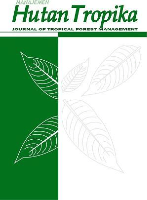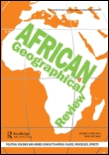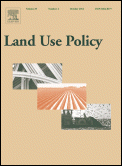
Regional Environmental Change
Scope & Guideline
Advancing Knowledge on Regional Ecosystem Changes
Introduction
Aims and Scopes
- Interdisciplinary Research on Environmental Change:
The journal publishes interdisciplinary studies that integrate natural and social sciences to address the complexities of environmental change and its impacts on regional systems. - Regional Adaptation Strategies:
Research on local and regional strategies for adapting to environmental changes, emphasizing community-based approaches and indigenous knowledge. - Land Use and Ecosystem Dynamics:
Focus on the analysis of land use changes and their implications for ecosystems, biodiversity, and human livelihoods, including the effects of agricultural practices, urbanization, and deforestation. - Climate Change Impacts and Mitigation:
Investigations into the impacts of climate change on various ecosystems and communities, along with studies on mitigation strategies and resilience building. - Sustainable Resource Management:
Exploration of sustainable practices in resource management, including water use, agriculture, and biodiversity conservation, aimed at enhancing ecological health and community resilience.
Trending and Emerging
- Climate Migration and Mobility:
An increasing number of studies are exploring the dynamics of climate-induced migration, addressing how communities adapt or relocate in response to environmental changes. - Community Resilience and Adaptation:
Research focusing on community resilience and adaptation strategies is on the rise, emphasizing participatory approaches and local knowledge in building adaptive capacities. - Socio-Ecological Systems and Governance:
Emerging research is delving into the governance of socio-ecological systems, analyzing how policies and institutional frameworks can better support sustainable practices and resilience. - Impact of Extreme Weather Events:
There is a growing emphasis on understanding the impacts of extreme weather events on ecosystems and human communities, particularly in the context of climate change. - Nature-Based Solutions:
Research exploring nature-based solutions for climate adaptation and mitigation is gaining traction, highlighting the potential of ecosystem services to address environmental challenges.
Declining or Waning
- Traditional Agricultural Practices:
Research on traditional agricultural practices and their impacts on the environment has decreased, possibly overshadowed by studies focusing on modern, sustainable, and climate-smart agriculture. - Historical Land Use Analysis:
While historical land use studies were once prevalent, there seems to be a waning interest, as more researchers focus on current and future scenarios rather than retrospective analyses. - Biodiversity Loss in Non-Agricultural Landscapes:
There has been less focus on biodiversity loss in non-agricultural landscapes, as attention shifts to agricultural biodiversity and its role in food security. - Local Ecological Knowledge:
Though still important, the emphasis on local ecological knowledge has diminished in favor of more quantitative, data-driven approaches to environmental research.
Similar Journals

FOLIA GEOBOTANICA
Innovating insights into ecological and evolutionary patterns.FOLIA GEOBOTANICA, published by Springer, is a distinguished journal dedicated to advancing the fields of Paleontology and Plant Science through the dissemination of high-quality research. With an ISSN of 1211-9520 and an E-ISSN of 1874-9348, this journal has been pivotal in providing a platform for innovative studies from 1994 to 2024. Notably, FOLIA GEOBOTANICA holds a Q3 ranking in Paleontology and a Q2 ranking in Plant Science as of 2023, affirming its relevance and contribution to the scholarly community. The journal is located in the Netherlands at VAN GODEWIJCKSTRAAT 30, 3311 GZ DORDRECHT, and is not an Open Access publication, ensuring comprehensive review processes and scholarly integrity. With Scopus rankings that place it in the 50th percentile for Plant Science and 46th for Paleontology, FOLIA GEOBOTANICA continues to attract researchers, professionals, and students who are keen to explore the intricacies of plant ecology and fossil records, thereby fostering a deeper understanding of ecological and evolutionary patterns.

Jurnal Manajemen Hutan Tropika
Connecting knowledge to nurture our forests.Jurnal Manajemen Hutan Tropika, with ISSN 2087-0469 and E-ISSN 2089-2063, is an esteemed academic journal published by the Bogor Agricultural University, Faculty of Forestry in Indonesia. Since its inception in 1999 as an Open Access journal, it has been dedicated to advancing knowledge in the fields of ecology, forestry, and related environmental sciences. Aiming to provide a robust platform for disseminating research, it has achieved notable rankings within Scopus, including a Q3 classification in Ecology and Ecology Evolution, as well as a Q2 ranking in Forestry for 2023. The journal's commitment to open access ensures that vital research findings are readily available to researchers, professionals, and students alike, fostering collaboration and innovation in tropical forest management. Located at KAMPUS IPB DARMAGA, BOGOR, JAWA BARAT, this journal continues to be a significant resource for enhancing sustainable forest practices and contributing to ecological understanding in the region and beyond.

African Geographical Review
Exploring the Rich Tapestry of Africa's Geographical DynamicsAfrican Geographical Review is a pivotal academic journal published by Routledge Journals, Taylor & Francis Ltd, whose mission is to advance knowledge and understanding of geographical dynamics across the African continent. With an ISSN of 1937-6812 and an E-ISSN of 2163-2642, this journal consistently delivers high-quality research, showcasing innovative perspectives and interdisciplinary approaches within the fields of Earth-Surface Processes and Geography, Planning and Development. Recognized in 2023 with a Q2 ranking in these categories, it ranks #231 out of 821 in Social Sciences and #63 out of 179 in Earth and Planetary Sciences according to Scopus metrics, reflecting its substantial impact and relevance. Featuring research that spans various geographic themes, the journal not only champions academic inquiry but also fosters a deeper understanding of spatial and environmental challenges unique to Africa. Engaging with a diverse audience of researchers, professionals, and students, the African Geographical Review serves as an indispensable resource for those committed to enhancing geographic scholarship and informing sustainable development practices across the continent.

LAND USE POLICY
Advancing Sustainable Solutions for Land Use ChallengesLAND USE POLICY, published by ELSEVIER SCI LTD, is a premier academic journal dedicated to advancing the study of land use issues and policies, with a particular focus on sustainable management and conservation practices. Since its inception in 1984, this journal has established itself as an influential platform in the fields of Forestry, Geography, Planning and Development, and Environmental Science, consistently achieving a Q1 category ranking across various disciplines. With an impressive impact factor and recognition as a top-tier source (e.g., ranking #18/821 in Geography and Planning), it serves as a critical resource for researchers, practitioners, and policy-makers looking to address complex land use challenges. Although it does not offer open access, the journal's articles are widely accessible through institutional subscriptions, enhancing its reach. Researchers and students can find valuable insights into innovative policies and methodologies that promote sustainable land management, making LAND USE POLICY essential reading for anyone engaged in environmental studies and policy development.

Geography and Natural Resources
Innovating Solutions for a Sustainable PlanetGeography and Natural Resources is a vital academic journal published by MAIK NAUKA/INTERPERIODICA/SPRINGER, focusing on diverse aspects of geography, natural resource management, and environmental sciences. With its ISSN 1875-3728 and E-ISSN 1875-371X, the journal serves as a platform for scholars and researchers to disseminate their findings in a rapidly evolving field. The journal holds a respectable Q3 ranking in the categories of Earth-Surface Processes and Geography, Planning and Development, as well as a Q4 ranking in Management, Monitoring, Policy, and Law, reflecting its commitment to quality research. Although it is not an open-access journal, it offers valuable insights and impactful articles tailored for professionals and academics interested in the intersection of human and environmental systems. By bridging theoretical and practical applications, Geography and Natural Resources plays a crucial role in guiding policies and enhancing understanding of sustainable development from 2008 to 2024 and beyond, making it an indispensable resource for the global scholarly community.

Acta Scientiarum Polonorum-Formatio Circumiectus
Championing open access to vital environmental knowledge.Acta Scientiarum Polonorum-Formatio Circumiectus is a distinguished open-access journal published by WYDAWNICTWO UNIWERSYTETU ROLNICZEGO HUGONA KOLLATAJA KRAKOWIE, dedicated to advancing knowledge in the fields of ecological modeling, environmental engineering, nature and landscape conservation, and water science and technology. With a commitment to accessibility since its inception in 2006, this journal provides a platform for researchers, professionals, and educators to disseminate their findings to a global audience. Although currently categorized in the Q4 quartile across various ecological disciplines, the journal's aim is to foster critical discussions and innovative approaches to pressing environmental challenges. The journal is based in Poland, and its scope encompasses a wide array of research areas pertinent to contemporary environmental studies. Acta Scientiarum Polonorum serves as an essential resource in its field, encouraging empirical research and theoretical advancements that collectively contribute to sustainable development and environmental stewardship.

Land
Exploring the Future of Sustainable Land PracticesLand is a premier open-access journal published by MDPI since 2012, dedicated to the interdisciplinary study of land use, management, and conservation. Based in Switzerland, this journal has rapidly established itself as a vital resource in the field, achieving impressive rankings in its categories: Q1 in Ecology and Nature and Landscape Conservation, and Q3 in Global and Planetary Change, reflecting its high impact in relevant scientific discourse. With an E-ISSN of 2073-445X, Land not only contributes to the advancement of knowledge but also fosters international collaboration among researchers, practitioners, and policymakers. The journal publishes high-quality peer-reviewed articles, offering a platform for innovative research and timely discussions surrounding land issues, ensuring accessibility and visibility through its open-access model. As it continues to converge from 2012 to 2024, Land is poised to play an influential role in shaping sustainable land practices and informing global environmental policies.

Regional Sustainability
Driving impactful research for a sustainable tomorrow.Regional Sustainability is a premier open access journal published by KEAI PUBLISHING LTD, devoted to the interdisciplinary exploration of sustainable practices within urban and regional contexts. Since its inception in 2020, this journal has quickly established itself as a leading platform for innovative research, currently holding a strong position in category quartiles, including Q1 rankings in Development and Geography, Planning and Development in 2023. With its broad scope encompassing essential themes in Renewable Energy and Urban Studies, Regional Sustainability provides valuable insights and advances knowledge critical for sustainable development, drawing contributions from scholars and practitioners worldwide. The journal’s impressive Scopus rankings underscore its significance with a percentile rank of 87th in both Urban Studies and Development, making it essential reading for researchers and policymakers alike. The journal is headquartered in Beijing, China, and is committed to disseminating high-quality research that addresses contemporary challenges in sustainability.

Revista Brasileira de Ciencias Ambientais
Cultivating Awareness and Action for Environmental ChallengesRevista Brasileira de Ciências Ambientais (ISSN: 1808-4524, E-ISSN: 2176-9478) is a prestigious open-access journal published by the Associação Brasileira de Engenharia Sanitária e Ambiental. Since its inception in 2005, this journal has played a vital role in disseminating innovative research and practical insights in the field of environmental sciences, focusing on both theoretical and applied aspects affecting Brazil and beyond. With a commitment to fostering knowledge exchange among researchers, policymakers, and practitioners, it addresses crucial topics such as environmental management, sustainability, and public health. The journal is housed in Rio de Janeiro, Brazil, and although specific metrics like H-Index or category quartiles are currently unavailable, its open-access model ensures wide visibility and accessibility, catering to a diverse audience of professionals and students passionate about protecting and enhancing our environmental systems.

Carpathian Journal of Earth and Environmental Sciences
Fostering Collaboration in Earth and Environmental ResearchCarpathian Journal of Earth and Environmental Sciences is a distinguished academic journal dedicated to advancing the interdisciplinary field of Earth and environmental sciences. Published by the Carpathian Association for Environment and Earth Sciences, this journal plays a pivotal role in disseminating high-quality research focused on the dynamic interactions between geological processes and environmental changes. With an ISSN of 1842-4090 and an E-ISSN of 1844-489X, the journal is indexed in Scopus and holds an esteemed Q3 quartile ranking in both Earth and Planetary Sciences and Environmental Science categories as of 2023. Since its inception in 2008, the Carpathian Journal has provided an open access platform for researchers, professionals, and students to share insights, foster collaboration, and engage in critical discussions on pressing environmental issues. By continuously contributing to the body of knowledge in this field, the journal not only enhances academic discourse but also promotes sustainable environmental practices across Romania and beyond.